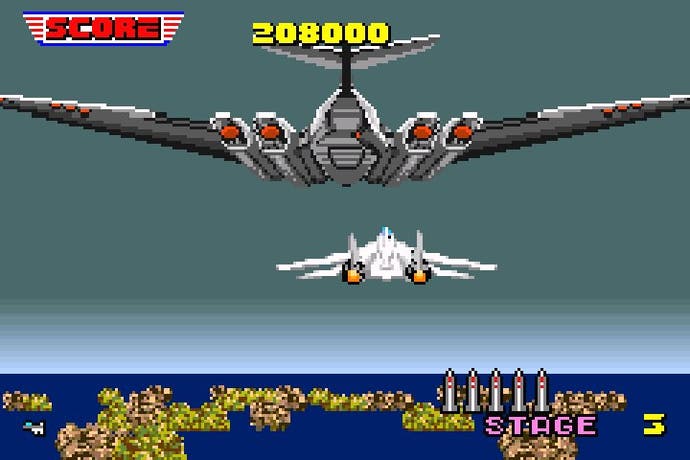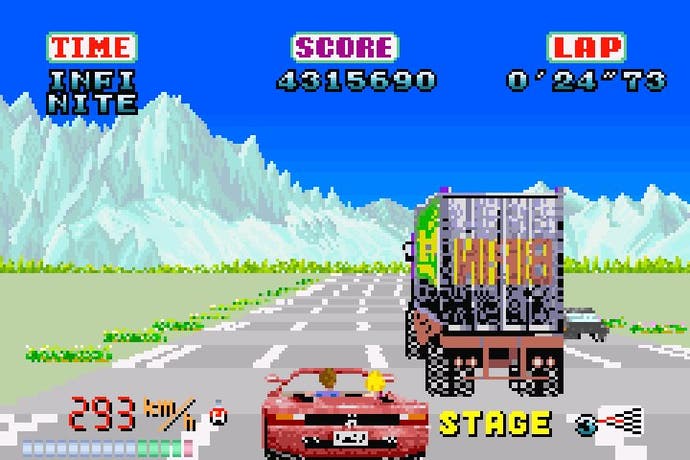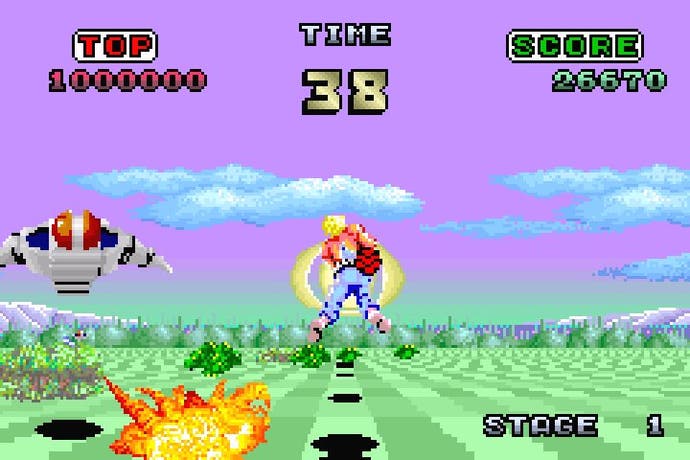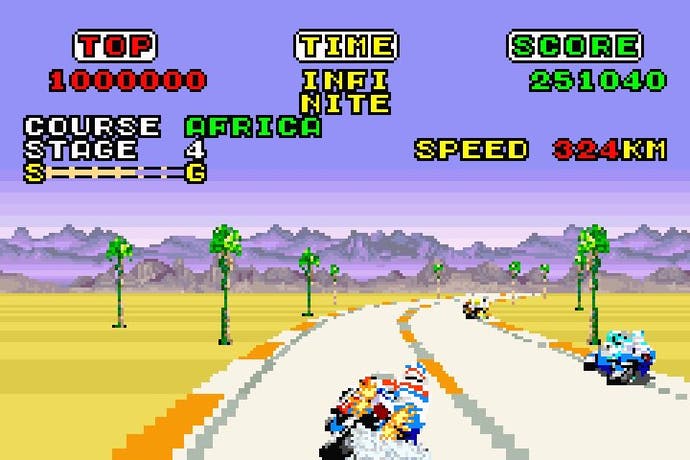Sega Arcade Gallery
As if it wasn't enough to swallow all your ten pence pieces...
The best and worst thing about the GBA is that it's given every publisher and developer the license to trawl back through the archives and revive some of the old classics. With the hundreds of classics released over the past twenty or more years to draw upon, the way is clear for a whole new audience to sample some simple, good old-fashioned gameplay in a an era when graphics didn't matter, blah blah, pure addictive one more go, blah.
The problem is, very few videogames stand the test of time, and revisiting some of the so-called classics invariably shatters those rose tinted spectacles in a matter of seconds.
A pocket full of change

Case in point is the Sega Arcade Gallery. Comprised of four solid gold arcade classics from 1985/86, we get OutRun, Space Harrier, Afterburner, and Super Hang On. Sounds like a nostalgist's wet dream doesn't it? For the more 'mature' among you, there are no doubt heady memories of hanging round the arcade gazing at the massive opulent cabinets with their wild hydraulic system, booming sound set up and massive screens. Or maybe you were mugged by the likes of US Gold and Elite, who churned out ugly conversions on the Speccy, Commodore and Amstrad?
Whatever. The chances are, most of you will have played these at some point or other and you'll probably have some deeply heartwarming tales of when you were a nipper relating to one or all of the aforementioned games. And why not? They were hugely impressive and ambitious games of their era that really defined and pushed the boundaries of 3D gaming when most developers were firmly stuck producing flat 2D games. The spirit of adventure in gaming in that era was truly breathtaking, and their place in history is assured.
But does that mean you'll want to pay £35 for them in 2003? If you want four absolutely 100 per cent spot on conversions of four all-time greats then of course, be our guest. You'll get exactly what it says on the box; a gallery of Sega Arcade classics, but what you won't get are games that stack up to anything released these days.
Money removal machines

It's perhaps stating the obvious, but it's worth detaching oneself from the dewy-eyed tendencies that retro gaming induces in its audience. All four games, in their time, were developed with one sole purpose; to extract money from its arcade audience. The best way to do that, in those days, was to make damned sure the games were over pretty quickly. This 'quick fix' mentality ensured that the culture within development was to make the games quite hard so that the player would be forced to rack up more coins and practice hard in order to get further.
These days, things couldn't be more different, and it's therefore pretty jarring adjusting to the gameplay ethos contained within this package. OutRun, for example, was perhaps the most popular arcade game of its era, and achieved this by tapping into everyone's mid '80s dream of wanting to drive a fast red sports car. The game couldn't be any simpler. All you do is drive as fast as you can against the clock, get to the next checkpoint before the time ticks down, and avoid the scenery and the traffic.
Along the way the road splits into two, and there are multiple routes to one of five eventual goals. It'll probably take the average gamer about seven minutes to reach the end, but take a fair bit of practice getting there, thanks to the really appalling handling which makes you appreciate quite how far things have come since these innocent days. You can always brake (with the B button), or switch down your gears (with the R button), but speed is of the essence. Wipe out more than once per leg and it's almost certainly Game Over.
Innovative. For their time.

Space Harrier, meanwhile, was exceptionally innovative for its time (check Rez out, if you want to see where the idea went). Guiding a jet pack fuelled chap through a series of obstacle strewn worlds at high velocity, while coming under heavy alien fire was a intoxicating take on the shoot 'em up genre in those days. Again, the more expensive cabinets featured hydraulics (as with all these games) and it was an incredibly exciting development in technology at the time, albeit prohibitively expensive for teens used to spending 10 pence (typically this new generation of arcade games were five times the price).
A slew of largely terrible ports revealed that, in reality, Space Harrier was just an exercise in visual pyrotechnics. The game itself, once you'd stripped away the layers, was actually quite unplayable, with objects and aliens appearing out of nowhere at insane speed, resulting in your untimely death time after time. Success largely depended on luck more than judgement, and on the tiny screen of the GBA this is even more the case. It simply doesn't old your attention anymore, and you'll quickly move onto the next games in the collection.
Super Hang On was an obvious sister title to OutRun (and itself the follow up to Hang On), and even gave arcade gamers the chance to mount a replica bike and actually lean into the corners for real. Needless to say, we thought this was the epitome of cool in 1986, and were only to happy to burn our pocket money trying to master it, as well as buy the inevitably rubbish US Gold conversion.
Nightmare controls

Somewhat harder than OutRun, the twitchy handling made it nightmare to get to grips with then, and it's even more the case now. Typically, the checkpoint approach to the gameplay means that more than one error and it's Game Over. We simply don't have the patience to forgive this kind of game design these days, and after repeated attempts just found the whole thing an unforgiving, rather hateful experience.
Afterburner was always our least favourite, and although its attempt at aerial-based combat was an impressive spectacle at the time (and tapped into the Top Gun fever prevalent during its release) its gameplay was too confusing and ambitious due to a graphics engine that couldn't really cope with what the designers were trying to achieve. Fast forward to 2003 and it serves as an interesting curiosity for those who want to see an early example of 3D aerial combat, but it's some way short of compelling or entertaining. Even for hopeless nostalgics, it soon grates.
Reducing each game to their base components is perhaps unkind, but when there's potentially £35 exiting your bank account, it's only fair to let you know. Visually none of them make the GBA even break sweat, which is probably stating the obvious, with exceptionally poor animation by even early '90s standards and blocky scaled sprites that were benchmark for their time, but 18 years on can hardly hope to excite anyone in this department. The audio, again, was unlike anything anyone had been treated to back then, but merely sounds like a Bontempi organ on demo play to these ears now. And finally, even the most passionate Sega fanboy would have to admit that they all play like a dog now - and the lack of battery back-up for the high scores is unforgivable.
How obsessive are you?
All four games were super ambitious 'period pieces' in the early stages of 3D gaming, but now can't hope to cut it in the demanding world if 2003. We'd also like to point out that Sega has a whole stack of arcade games in its archives, and could have been a mite more generous than including just four in the package. One for obsessives only.








